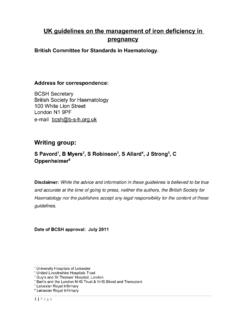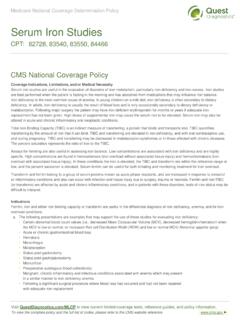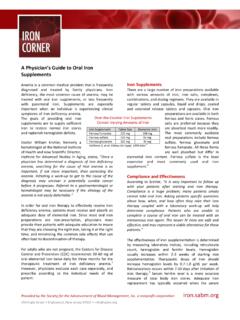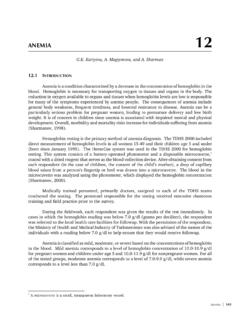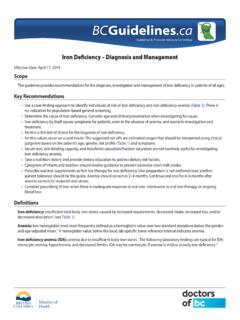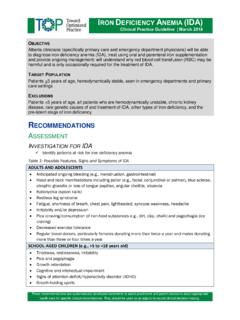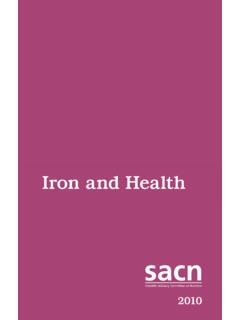Transcription of National Coverage Determination Procedure Code: 82728 ...
1 National Coverage Determination Procedure Code: 82728 , 83540, 83550, 84466 Serum iron Studies CMS Policy Number: Back to NCD List Description: Serum iron studies are useful in the evaluation of disorders of iron metabolism, particularly iron deficiency and iron excess. iron studies are best performed when the patient is fasting in the morning and has abstained from medications that may influence iron balance. iron deficiency is the most common cause of anemia . In young children on a milk diet, iron deficiency is often secondary to dietary deficiency . In adults, iron deficiency is usually the result of blood loss and is only occasionally secondary to dietary deficiency or malabsorption. Following major surgery the patient may have iron deficient erythropoietin for months or years if adequate iron replacement has not been given.
2 High doses of supplemental iron may cause the serum iron to be elevated. Serum iron may also be altered in acute and chronic inflammatory and neoplastic conditions. Total iron Binding Capacity (TIBC) is an indirect measure of transferring, a protein that binds and transports iron . TIBC quantifies transferring by the amount of iron that it can bind. TIBC and transferring are elevated in iron deficiency , and with oral contraceptive use, and during pregnancy. TIBC and transferring may be decreased in malabsorption syndromes or in those affected with chronic diseases. The percent saturation represents the ratio of iron to the TIBC. Assays for ferreting are also useful in assessing iron balance. Low concentrations are associated with iron deficiency and are highly specific. High concentrations are found in hemosiderosis ( iron overload without associated tissue injury) and hemochromatosis ( iron overload with associated tissue injury).
3 In these conditions the iron is elevated, the TIBC and transferrin are within the reference range or low, and the percent saturation is elevated. Serum ferritin can be useful for both initiating and monitoring treatment for iron overload. Transferrin and ferritin belong to a group of serum proteins known as acute phase reactants, and are increased in response to stressful or inflammatory conditions and also can occur with infection and tissue injury due to surgery, trauma or necrosis. Ferritin and iron /TIBC (or transferrin) are affected by acute and chronic inflammatory conditions, and in patients with these disorders, tests of iron status may be difficult to interpret. Indications: 1. Ferritin, iron and either iron binding capacity or transferrin are useful in the differential diagnosis of iron deficiency , anemia , and for iron overload conditions.
4 A. The following presentations are examples that may support the use of these studies for evaluating iron deficiency : Certain abnormal blood count values ( , decreased Mean Corpuscular Volume (MCV), decreased hemoglobin/hematocrit when the MCV is low or normal, or increased Red cell Distribution Width (RDW) and low or normal MCV) Abnormal appetite (pica) Acute or chronic gastrointestinal blood loss Hematuria Menorrhagia Malabsorption Status post-gastrectomy Status post-gastrojejunostomy Malnutrition Preoperative autologous blood collection(s) Malignant, chronic inflammatory and infectious conditions associated with anemia which may present in a similar manner to iron deficiency anemia Following a significant surgical Procedure where blood loss had occurred and had not been repaired with adequate iron replacement.
5 B. The following presentations are examples that may support the use of these studies for evaluating iron overload: Chronic Hepatitis Diabetes Hyperpigmentation of skin Arthropathy Cirrhosis Hypogonadism Hypopituitarism Impaired porphyrin metabolism Heart failure Multiple transfusions Sideroblastic anemia Thalassemia major Cardiomyopathy, cardiac dysrhythmias and conduction disturbances 2. Follow-up testing may be appropriate to monitor response to therapy, , oral or parenteral iron , ascorbic acid, and erythropoietin. 3. iron studies may be appropriate in patients after treatment for other nutritional deficiency anemias, such as folate and vitamin B12, because iron deficiency may not be revealed until such a nutritional deficiency is treated. 4. Serum ferritin may be appropriate for monitoring iron status in patients with chronic renal disease with or without dialysis.
6 5. Serum iron may also be indicated for evaluation of toxic effects of iron and other metals ( , nickel, cadmium, aluminum, and lead) whether due to accidental, intentional exposure or metabolic causes. Limitations: 1. iron studies should be used to diagnose and manage iron deficiency or iron overload states. These tests are not to be used solely to assess acute phase reactants where disease management will be unchanged. For example, infections and malignancies are associated with elevations in acute phase reactants such as ferritin, and decreases in serum iron concentration, but iron studies would only be medically necessary if results of iron studies might alter the management of the primary diagnosis or might warrant direct treatment of an iron disorder or condition. 2. If a normal serum ferritin level is documented, repeat testing would not ordinarily be medically necessary unless there is a change in the patient s condition, and ferritin assessment is needed for the ongoing management of the patient.
7 For example, a patient presents with new onset insulin-dependent diabetes mellitus and has a serum ferritin level performed for the suspicion of hemochromatosis. If the ferritin level is normal, the repeat ferritin for diabetes mellitus would not be medically necessary. 3. When an End Stage Renal Disease (ESRD) patient is tested for ferritin, testing more frequently than every three months requires documentation of medical necessity ( , other than chronic renal failure or renal failure, unspecified). 4. It is ordinarily not necessary to measure both transferrin and TIBC at the same time because TIBC is an indirect measure of transferrin. When transferrin is ordered as part of the nutritional assessment for evaluating malnutrition, it is not necessary to order other iron studies unless iron deficiency or iron overload is suspected as well.
8 5. It is not ordinarily necessary to measure either iron /TIBC (or transferrin) and ferritin in initial patient testing. If clinically indicated after evaluation of the initial iron studies, it may be appropriate to perform additional iron studies either on the initial specimen or on a subsequently obtained specimen. After a diagnosis of iron deficiency or iron overload is established, either iron /TIBC (or transferrin) or ferritin may be medically necessary for monitoring, but not both. 6. It would not ordinarily be considered medically necessary to do a ferritin as a preoperative test except in the presence of anemia or recent autologous blood collections prior to the surgery. Frequency Limitations: If a normal serum ferritin level is documented, repeat testing would not ordinarily be medically necessary unless there is a change in the patient's condition, and ferritin assessment is needed for the ongoing management of the patient.
9 When an End Stage Renal Disease (ESRD) patient is tested for ferritin, testing more frequently than every three months (the frequency authorized by , Fiscal Intermediary manual) requires documentation of medical necessity [ , other than Chronic Renal Failure (ICD-9-CM 585) or Renal Failure, Unspecified (ICD-9-CM 586)]. To review all requirements of this policy, please see: CMS NCD listing by Chapter Covered ICD-10 Codes. ICD-10 Descriptor Typhoid fever, unspecified Typhoid meningitis Typhoid fever with heart involvement Typhoid pneumonia Typhoid arthritis Typhoid osteomyelitis Typhoid fever with other complications Paratyphoid fever A Paratyphoid fever B Paratyphoid fever C Paratyphoid fever, unspecified Salmonella enteritis Salmonella sepsis Localized salmonella infection, unspecified Salmonella meningitis Salmonella pneumonia Salmonella arthritis Salmonella osteomyelitis Salmonella pyelonephritis Salmonella with other localized infection Other specified salmonella infections Salmonella infection.
10 Unspecified Enteropathogenic Escherichia coli infection Enterotoxigenic Escherichia coli infection Enteroinvasive Escherichia coli infection Enterohemorrhagic Escherichia coli infection Other intestinal Escherichia coli infections Campylobacter enteritis Enteritis due to Yersinia enterocolitica Enterocolitis due to Clostridium difficile, recurrent Enterocolitis d/t Clostridium difficile, not spcf as recur Other specified bacterial intestinal infections Bacterial intestinal infection, unspecified Acute amebic dysentery Chronic intestinal amebiasis Amebic nondysenteric colitis Ameboma of intestine Amebic liver abscess Amebic lung abscess Amebic brain abscess Cutaneous amebiasis Amebic cystitis Other amebic genitourinary infections Other amebic infections Amebiasis, unspecified Balantidiasis Giardiasis [lambliasis]


